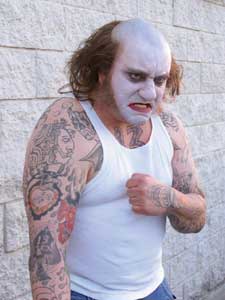![[Metroactive Music]](/music/gifs/music468.gif)
[ Music Index | Santa Cruz Week | SantaCruz Home | Archives ]
Müz
Fears of a Clown
By Bill Forman
Deconstructionists may rail against the traditional Western view of society as a series of binary opposites, but there is still one virtually universal dichotomy that even the most determined relativist would have difficulty debating. I'm talking, of course, about the distinction between clowns and mimes.
Indeed, our world becomes infinitely more understandable when seen through the lens of these primal archetypes; so much so, in fact, that Jungian analysis, Enneagrams and the rest of New Age inquiry suddenly seem unnecessary, even counterproductive.
Who among us does not fall into either the camp of the insufferably effete and passive-aggressive (mimes) or the camp of the indiscriminately gregarious (clowns)?
America, of course, has always been a nation of clowns. Only in recent decades have mimes, and all that they stand for, made inroads into our culture, and not without resistance. Incidents of clown-on-mime violence are so common that they have been enshrined in our culture, most recently in Elias Matar's 2005 short, Chingaso the Clown, part of this year's Cinequest Film Festival (See also: Shakes the Clown, 1992). The mime's ability to transcend the language barrier, inspiring universal hatred without uttering a single word, is still amazing to behold.
Even as mimes have taken a beating (literally and figuratively), clowns have also suffered a decline in status when it comes to contemporary culture. Floppy shoes, fake noses and red fright wigs--once the province of unshaved men whose worst sins were to drive drunk in overpopulated clown cars--are now associated with increasingly diabolical figures, from Bozo and Krusty to Ed Gein to Ronald McDonald.
All of which may explain why, last week, when a friend offered last-minute tickets to see Cirque Du Soleil in San Jose, I felt a definite sense of trepidation. Essentially the mime counterpart to Ringling Brothers' clown-identified enterprise, Cirque Du Soleil has grown into a larger than life phenomenon via Imax screens and slick Las Vegas spectacles. In fact, the Cirque franchise is now so massive that it's easy to forget they started out as a simple band of street performers in the '80s.
Fortunately, the troupe itself hasn't forgotten. Corteo takes Cirque Du Soleil back inside the Big Top where they belong. Inside the circus tent, the show is built around a suitably minimal narrative--a middle-aged clown conjuring up a variety of fantasies, including his own death--and the spectacle is combined with elements of bittersweet comedy that brings out the humane qualities in performers who just happen to be capable of superhuman feats.
As the performers returned to the ring for their final bows, it was as if we were all somehow a shared community. It brought back nostalgic Ed Sullivan memories of Russian acrobats and Yugoslavian plate-spinners, as well as more recent touchstones like the dearly departed Carnivale series--but, in this case, without the Dust Bowl poverty, senseless lynchings and homicidal clergy. Plus, I hardly need point out, not one single mime.
Copyright © 2005 Metro Publishing Inc. Maintained by Boulevards New Media.
For more information about Santa Cruz, visit santacruz.com.
![]()

Chingaso the Clown: Will he overcome his primal instincts and put an end to clown-on-mime violence?
Cirque du Soleil's Corteo, Taylor Street Bridge, San Jose, through March 5; www.cirquedusoleil.com. Chingaso the Clown, Cinequest Film Festival, March 3�4, 11:45pm; Camera 12, 201 S. Second St., San Jose; www.cinequest.org. Carnivale: The Complete First Season, HBO Home Video.
From the February 22-March 1, 2006 issue of Metro Santa Cruz.